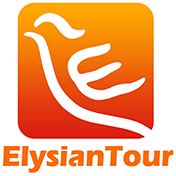Yellow Mountain
- Elevation: 1,864 meters (6,115 feet)
- Area: 16,060 hectares
- Location: Huangshan, Anhui Province, China
- Four Wonders: peculiar peaks, twisted pine trees, sea of clouds and hot springs
- Best Time to Visit: four seasons
- Destination Type: nature, adventure, hiking, photography
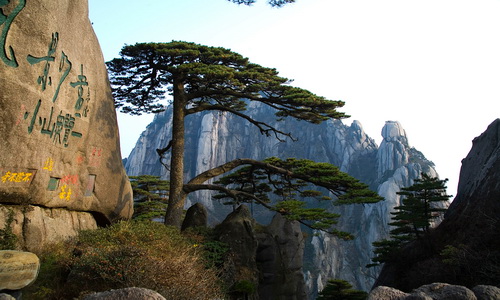
As a UNESCO World Heritage Site since 1990, Yellow Mountain has always been a prestigious getaway for travel-addicts domestic and abroad. As one of the most visited mountains of China, Yellow Mountain is blessed with spectacular natural beauty of four wonders including oddly-shaped granite peaks, twisted pine trees, sea of clouds and hot springs, in addition to the stunning sunrise, sunset and Buddha's Light. Yellow Mountain also fosters profound history and culture cultivated by a great number of brilliant poets and painters who drew inspiration from the breathtaking scenery of Yellow Mountain. It is a rather popular subject in traditional Chinese scroll ink paintings and literature, which is a must-see destination if you are searching a natural escape from the hustle and bustle of the temporal world.
Yellow Mountain is endowed with a great number of grotesque granite peaks and peculiar rocks, and your imagination would be greatly inspired by their spectacular shapes. Some mist-wreathed peaks resemble lively human beings and animals, while some looks like brush pens and bridges. Most oddly-shaped peaks and rocks are named by their appearances and legend stories, such as the Flying-Over Rock, Celestial Basking Shoe, Monkey Watching the Sea and Immortal Pointing the Way. Particularly, the stark Flying-Over Rock is one of the most symbolic rock in the Yellow Mountains, towering abruptly at the top of a peak with an amazing height of 12 meters.
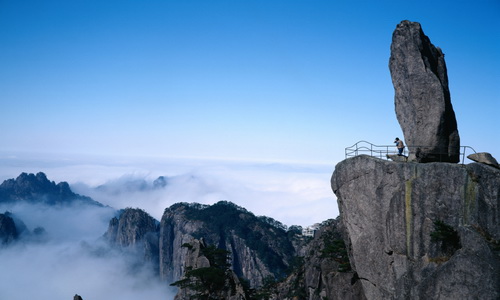
The peculiar-looking pine trees are the top one wonder of the Yellow Mountain. Tree-shrubs of pines nearly cover all the jutting crags of 72 peaks, stretching their flat pans of leaves and incredibly gnarled branches. These twisted pines rooted in the barren crevices grow breadthwise, straightforward or downward, which create spots in thousands of postures. Among them, the Greeting Guest Pine in Jade Screen Scenic Area has always been regarded as the symbol of the Yellow Mountain, and been immortalized in numerous Chinese scroll paintings and movies.
Yellow Mountain is one of the best places to see the sea of clouds in China. The crest of the peaks offers fascinating views of the clouds and mists from above, which partly hides the oddly shaped rocks and verdant pines like islets floating on the sea. Drifting with the wind, the scudding clouds surge like the waves and ripples on the sea. Fairytale vistas of the sea of the clouds could be captured on the Lotus Peak, the Heaven Capital Peak and the Brightness Summit.
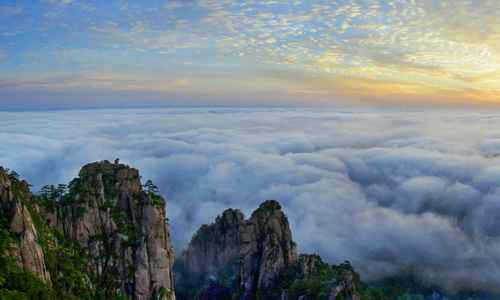
Blessed with geothermal resources, Yellow Mountain boasts abundant hot springs at the mountain foot as one of its four wonders that were discovered about one thousand years ago. Tourists could have a refreshing medical experience by a warm bath after hiking down from the mountain.
Yellow Mountain absolutely has the most stunning views of sunrise and sunset among all the magnificent mountains in China. A phenomenon known as Buddha's Light is also a rare and glorious spectacle of Yellow Mountain that may appear a couple of times per month. Usually you need to arrive about one hour early to shoot better pictures as the viewing locations could be super crowded. Generally, you need to stay for one overnight at least on the mountain so as to catch the sunrise and sunset scene both.
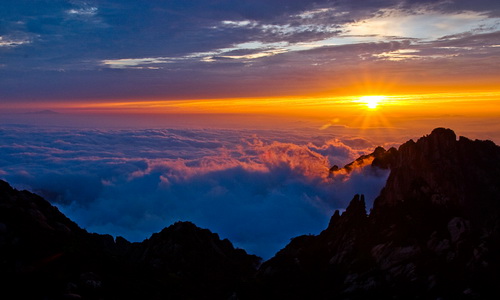
Best Places for Photography:
Sunrise: Dawn Pavilion, Refreshing Platform, Lion Peak, Rosy Clouds Peak, Bright Peak Summit, Jade Screen Peak, Lotus Blossom Peak, and Heavenly Capital Peak.
Sunset: Bright Summit, Turtle Peak, Gongyang Peak, Flying-Over Stone, and Cloud-dispelling Pavilion.
Buddha's Light: Shixin Peak (Begin-to-Believe Peak)
- Recommended Travel Route:
- Entire Hiking Route:
Yungu Cable Car - White Goose Ridge - Begin to Believe Peak - West Sea Grand Canyon - Lion Peak - Yungu Cable Car
Navigating by this popular trekking route, you are able to cover a lot of brilliant spots of Yellow Mountain, including the Monkey Watching the Sea, Children Worshiping the Goddess Guanyin, Couple Pine, Black Tiger Pine and Blooming Pen in Dream as well as precipitous cliffs of the canyons and the awesome sunrise views.
If you fancy this classic hiking route, our Huangshan Essence Exploration would be exactly served for your needs.
Mercy Light Pavilion - Jade Screen Peak - Bright Summit - West Sea Canyon - Cloud-Dispelling Pavilion - Fairy-walking Bridge – Lion Peak – Begin to Believe Peak- Yungu Temple
Hiking addicts are offered a chance to accomplish a 12-mile roundtrip trekking journey on the Yellow Mountain. During three days and two nights, you could absorb nearly all the highlights of Mt. Huangshan, such as the breathtaking sunrise & sunset, countless twisted pine trees, oddly-shaped rocks and engrossing valleys.
More details about our Yellow Mountain Hiking Tour.
Perched in the south of Anhui Province, Yellow Mountain gets four distinctive seasons that are perfect for a trip all year round. Generally, there is no bad time to visit Yellow Mountain as the mountain has so much to offer in different ways at different times of the year.
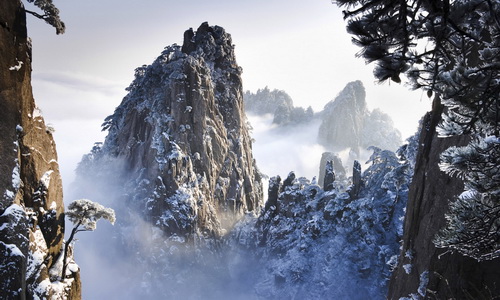
The spring season of the Yellow Mountain is from March to May when flower blooms, hills turn green and warm breeze brushes. The summer from June to August is the best time to catch the awesome sunrise and sunset views especially on clear days. Autumn is the most comfortable and pleasant periods for you to capture unblocked views the colorful foliage in the valleys, while winter of the Yellow Mountain lasts from December to February, which is perfect season to discover the sea of clouds and the crystal wonderland with snow-covered peaks and lofty pine trees.
Aside from the natural beauties of Yellow Mountain, there are an array of ancient towns, villages and streets hidden around the mountain, such as Hongcun, Xidi, Chengkan, Tunxi and Shexian. You could make a side trip to absorb the centuries-old Hui style folk residence, capture insights into traditional customs and lifestyle of local people and soak up the idyllic countryside view as well.
Get to Huangshan City
- By Air:
- By Rail:
- By Bus:
Huangshan enjoys very convenient air transportation from most big cities and tourist destinations of China, such as Beijing, Xian, Guangzhou, Guilin, Kunming and Chengdu.
However, bullet train is the most popular travel methods to reach Huangshan from Beijing, Shanghai and Hangzhou. There are frequent high-speed trains leading to Huangshan City, with a duration of about 6 hours.
Besides, it is rather easy to make an extension trip connecting from Shanghai, Hangzhou, Nanjing and Hefei as there are a lot of tourist buses running to the scenic area directly.
Get to the Yellow Mountain Scenic Area
For traveler reaching Huangshan by plane or train, they usually land at Tunxi District that is about 40 miles from the South Entrance (most popular entrance, accessible for hiking and Yungu cable car) at Tangkou Town.
From airport and downtown
- You can take a taxi from the airport to Huangshan General Bus Station at a cost of about CNY20, and then connect regular buses to Tangkou (near south entrance) directly.
- Alternatively, you could have a taxi ride to the scenic area directly, which may cost CNY180 - 200 around.
1. Yellow Mountain is quite popular and you are suggested to get up early to avoid long queues for the tickets.
2. There is a large temperature difference between the mountaintop and foot. You need to wear layers to keep warm.
3. Besides, the weather is quite changeable on the mountains, and it often drizzles suddenly. Thus you are advised to pack your rain gears.
4. It is wise to carry some snacks as the food on the mountains is limited and expensive.
5. There are multiple accommodation choices on Yellow Mountain, and we suggest you choose one for an easier access to the viewing platform for sunrise, such as the Bright Summit, Clouds Dispelling Pavilion and White Goose Peak.
6. Never go on a weekend or during Chinese holidays like the National Day (Oct. 1 - 7), but it is not bad during Chinese lunar New Year.
High Season (Mar. 1 - Nov. 30): CNY 230
Slack Season (Dec. 1 - Feb. 28): CNY 150
Cable Car Price:Taiping Cableway: CNY 80 in peak season; CNY65 in slack season
Yungu Cableway: CNY 80 in peak season; CNY65 in slack season
Yuping Cableway: CNY 90 in peak season; CNY75 in slack season
West Sea Valley Cableway: CNY 100 in peak season; CNY80 in slack season
Note:1. The admission ticket is valid for two days.
2. Children below 1.2 meters (3.9 feet) could enjoy free entry.

